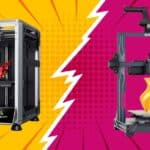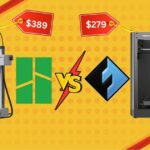
3D printed wall hooks offer a customizable, innovative way to organize and decorate. Ideal for light items with the right filament and setup, they may need durable materials and secure mounting for heavier loads. Test their capacity or opt for stronger alternatives if needed.
Ever thought about using a 3D printed wall hook but felt uncertain if it could hold the weight of your items? As 3D printing gains popularity, people are testing its limits in practical applications. A wall hook is a great example—a small but handy tool that helps organize, decorate, or even create a unique aesthetic for your space. But when it comes to heavy items, can these hooks made of plastic actually hold up? Let’s dive into what makes a 3D printed hook durable, explore its limitations, and give some tips for making sure they work as intended.
Affiliate Disclosure
We participate in Amazon affiliate programs, earning fees from qualifying purchases via links at no extra cost to you. It’s how we keep this blog rolling and my 3D printers buzzing with fresh filament for reviews like this one!
Related: Are 3D Printed Coffee Mugs Safe for Hot Liquids?
Understanding 3D Printed Wall Hooks
3D printed wall hooks are made through a process called additive manufacturing, where a 3D printer deposits material layer by layer to build an object. This unique process allows for a high level of customization, enabling you to create hooks in all shapes and sizes.
However, the strength of a 3D printed hook depends on the material used. Common materials include:
- PLA (Polylactic Acid): Easy to print and eco-friendly but can be brittle, especially under weight or impact.
- ABS (Acrylonitrile Butadiene Styrene): Stronger and more durable than PLA, but it requires higher temperatures to print.
- PETG (Polyethylene Terephthalate Glycol): A middle-ground option, PETG offers durability and flexibility, making it better for hooks that may carry moderate weight.
Each of these materials has distinct properties that affect how much weight the hook can bear. The print settings, as we’ll discuss below, also play a role in their load-bearing abilities.
Factors That Influence Load-Bearing Capacity
Material Choice
The choice of filament determines a significant part of a hook’s strength. For instance, PLA is affordable and easy to print but isn’t known for durability under stress. For heavy items, consider using more robust materials like ABS or PETG, or even stronger filaments like carbon fiber-infused PLA or polycarbonate.
Print Settings
Adjusting the printer settings can greatly enhance the strength of a wall hook:
- Layer Thickness: Thicker layers tend to provide more structural integrity.
- Infill Percentage: This determines the density of the hook. Higher infill (70–100%) creates a denser, stronger hook.
- Wall Thickness: Thicker walls give additional reinforcement, especially if the hook is designed to carry heavier items.
Wall Type and Mounting Technique
Where and how you mount the hook can make a huge difference:
- Drywall vs. Concrete: Hooks mounted on concrete or wood are far more secure than those on drywall.
- Mounting Technique: Adhesive-backed hooks may be convenient but usually can’t bear much weight. For heavier items, screws or wall anchors provide a more secure hold.
Hook Design and Shape
Some hook designs inherently handle weight better. For example, hooks with a longer arm or a slight curve distribute weight more evenly. Angular designs or thicker hooks add additional strength, minimizing the risk of bending or breaking under weight.
Related: 3D Printer Maintenance 101: Essential Tips
Testing Weight Limits on 3D Printed Hooks
Testing the weight limits of 3D printed hooks can help determine if they’re ready for real-world use. Here are some simple ways to test their load-bearing capacity at home:
- Gradual Weight Test: Start with a lighter item and gradually add weight. You might begin with something like a kitchen towel, then try a coat, and then add increasingly heavier items.
- Real-Life Scenarios: Think of practical uses: a coat, bag, or lightweight tools. Each of these items has a rough weight range that you can use to estimate the maximum weight your hook can hold.
Tips for Safe Usage
- Regular Inspections: Look for signs of stress, such as small cracks or discoloration, especially around areas that bear the most load.
- Safe Limits: Don’t push the limits of what your hook can bear; leave some margin for safety.
Alternative Solutions for Heavy Items
Risks of Overloading 3D Printed Hooks
3D printed hooks, especially those made of PLA or low-density materials, might break or crack if overloaded. If the stakes are high—like hanging a family-sized coat rack or heavy tools—you may want to look for alternative options.
Metal and Reinforced Hooks as Stronger Alternatives
For heavy items, you might consider traditional metal or reinforced hooks. These are manufactured specifically for strength and can often support much more weight than their 3D printed counterparts. You can still use 3D printed hooks for lighter items, like keys or picture frames, where the risk of damage is minimal.
Related: 3D Home Decor Mistakes to Avoid:A Beginner’s Guide
Tips for Maximizing the Strength of 3D Printed Wall Hooks
If you’re set on using 3D printed hooks for heavier items, here are a few tips to help:
- Use High-Quality Filament: Advanced materials like carbon fiber-infused filament or polycarbonate are stronger and more resilient than standard PLA or ABS.
- Optimize Print Settings: As mentioned, thicker layers, higher infill, and additional wall thickness all contribute to a sturdier hook.
- Mount Hooks Securely: Screws or wall anchors provide a more stable attachment than adhesive strips or simple nails, distributing weight more evenly and helping to prevent failure.
Conclusion
In conclusion, 3D printed wall hooks are an innovative, customizable solution for organizing and decorating your space, but they come with some limitations. If you plan to use them for lighter items, they should work well with the right material and setup. For heavier items, however, it’s essential to choose a durable filament, optimize your print settings, and secure your hooks with solid mounting.
Ultimately, 3D printed hooks work best for those who want a unique, lightweight solution. For anyone considering using them for substantial weights, it’s important to test their capacity and, if in doubt, go with a stronger alternative. Got questions or stories about your own 3D printed hooks? Share them below!
Frequently Asked Questions (FAQs)
Can 3D Printed Wall Hooks Hold Heavy Items?
Yes, 3D printed wall hooks can hold heavy items, but it depends on factors like material, design, wall type, and installation. For best results, choose strong materials, well-designed hooks, and secure installation.
What is the maximum weight a 3D printed wall hook can hold?
The weight capacity of a 3D printed wall hook depends on several factors, including the material used, print settings, and design. With strong materials like PETG or carbon-fiber infused PLA and high infill density, hooks can typically hold between 5 to 15 pounds. However, exceeding 5 pounds may reduce the hook’s lifespan, so it’s best to test each hook carefully.
Which materials are best for making strong 3D printed wall hooks?
PETG, ABS, and polycarbonate are some of the most suitable materials for strength and durability in 3D printed wall hooks. If you need additional strength, consider a filament reinforced with carbon fiber or other high-strength additives. PLA, while commonly used, is not ideal for weight-bearing hooks due to its brittleness.
Can 3D printed wall hooks be used on all types of walls?
Yes, but how you mount them matters. For drywall, it’s best to use screws and anchors to secure the hooks. Mounting on concrete or wooden walls typically provides more stability and can bear greater weight. Avoid using adhesive strips alone, as they may not support heavy loads on any wall type.
What print settings help improve the strength of 3D printed wall hooks?
Key print settings include a high infill percentage (70–100%), thick walls, and thicker layers. These settings add structural integrity to the hook, making it more capable of holding weight. Higher infill density and increased wall thickness help distribute weight more effectively and reduce the risk of failure
Are 3D printed wall hooks suitable for hanging valuable or breakable items?
It’s best to avoid using 3D printed hooks for valuable or breakable items, as even strong prints may fail under unexpected stress. For high-value or delicate items, consider using metal or commercially reinforced hooks designed to handle heavier loads reliably.













